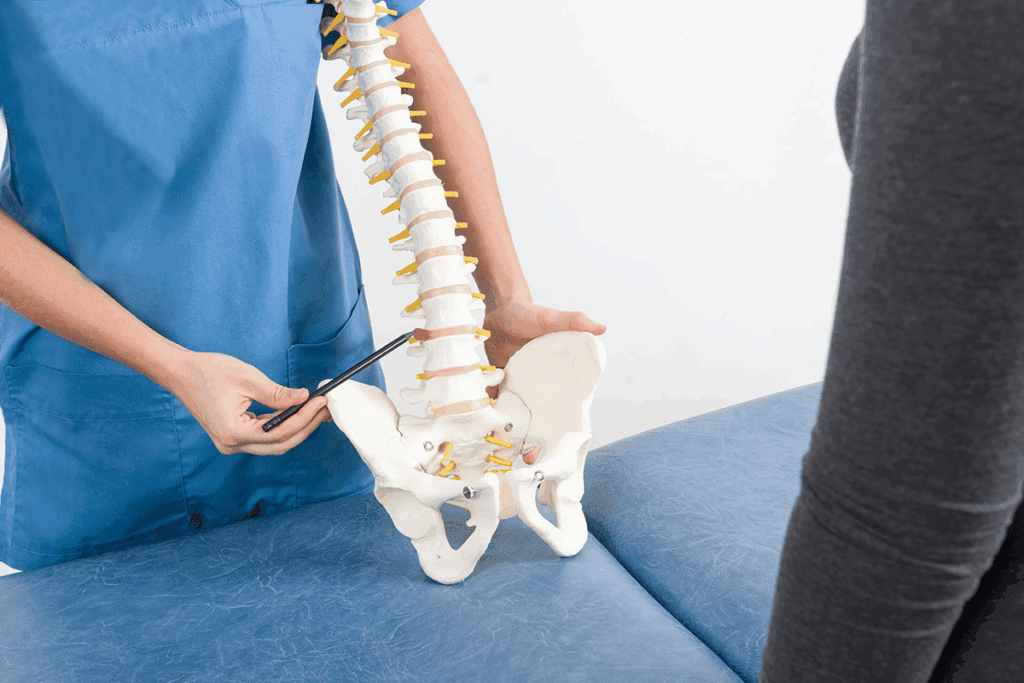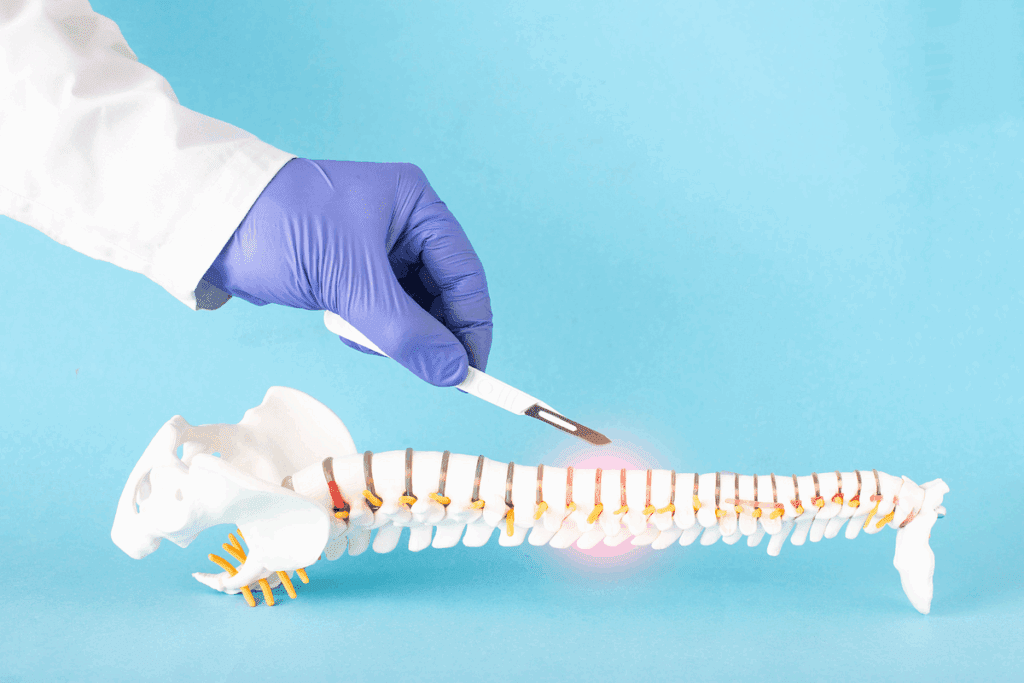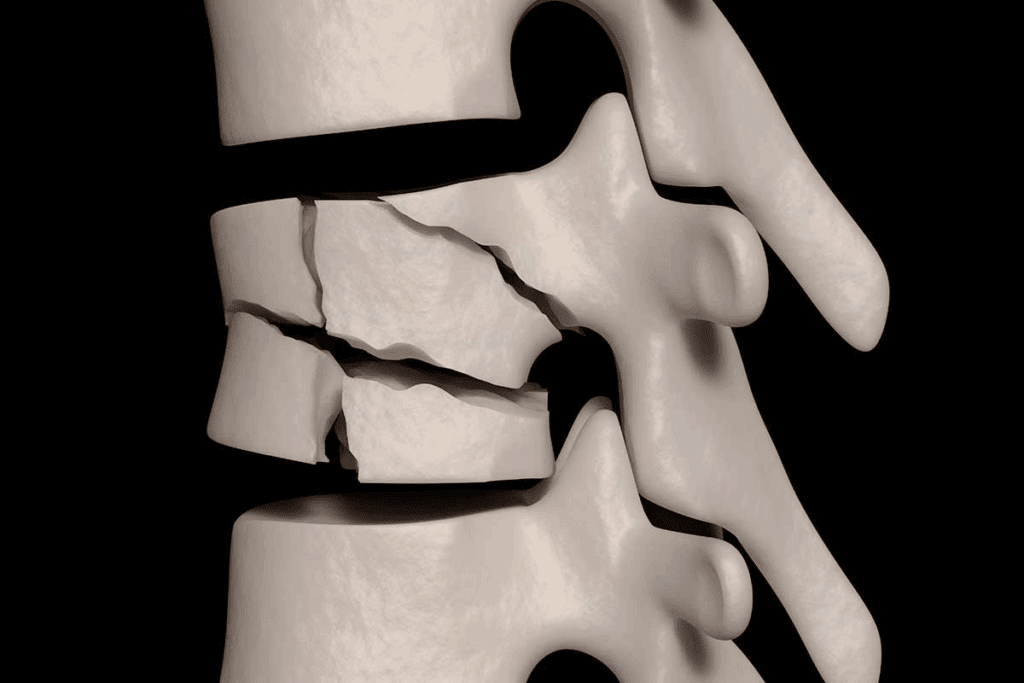Last Updated on October 30, 2025 by mcelik

Learn how to fix broken vertebrae with cement surgery. This ultimate guide explains vertebroplasty and kyphoplasty procedures simply.
For those dealing with spinal fractures, knowing about cement surgery is key. Liv Hospital is known for its focus on patients and its advanced cement treatments. These help bring back mobility and improve life quality.
Vertebroplasty and kyphoplasty are minimally invasive procedures. They stabilize spinal fractures by filling the affected vertebrae with special cement. These steps can greatly reduce pain and enhance movement.
Cement surgery uses a liquid bone cement material injected through a needle into the vertebrae. It acts like glue, holding the vertebrae together. This method has proven effective in treating broken vertebrae.

Vertebral fractures can greatly affect a person’s life. They happen when a vertebra collapses. This can be due to osteoporosis or trauma.
Most vertebral fractures are linked to osteoporosis. Osteoporosis weakens bones, making them more prone to fractures. High-energy injuries and cancer can also cause these fractures.
Being older, female, or having a family history of osteoporosis increases the risk. Smoking, not exercising, and poor diet also play a part.
Symptoms of vertebral fractures vary. They often include acute back pain that is severe. People may also notice a decrease in height or changes in posture.
In some cases, a kyphotic deformity (spinal curvature) can occur. If the fracture presses on nerves, neurological symptoms may appear.
Diagnosing vertebral fractures involves clinical checks and imaging. X-rays are often used to spot fractures. For more detailed views, MRI or CT scans might be needed.
Finding the right diagnosis is key to choosing the best treatment. This could include cement procedures like vertebroplasty or kyphoplasty. These involve cement injection in spine to stabilize the vertebra.

For those with broken vertebrae, cement-based surgeries offer a good solution. They help with pain and keep the spine stable. These methods are less invasive and help fix the spine.
Vertebroplasty is a procedure where bone cement is injected into a broken vertebra. It helps ease pain and makes the spine stable. The surgery is done under local anesthesia and with imaging to place the cement right.
Kyphoplasty is a procedure for broken vertebrae, similar to vertebroplasty. But it uses an inflatable balloon first to make space in the vertebra. Then, bone cement is injected. This method helps restore the vertebra’s height and lowers the chance of cement leaking.
Both vertebroplasty and kyphoplasty use Polymethylmethacrylate (PMMA), a bone cement, in the vertebra. The cement hardens fast, giving the spine stability and easing nerve pressure. Imaging, like fluoroscopy, helps place the cement correctly.
| Procedure | Description | Key Benefits |
| Vertebroplasty | Injects bone cement directly into the fractured vertebra | Pain relief, spinal stabilization |
| Kyphoplasty | Uses an inflatable balloon to create space before cement injection | Restores vertebra height, reduces cement leakage risk |
Choosing between vertebroplasty and kyphoplasty depends on the fracture’s severity and the patient’s health. Both methods offer significant pain relief and improve life quality for those with vertebral fractures.
When other treatments don’t work, cement surgery is often suggested. It’s a small procedure where cement is injected into a broken vertebra. This helps stabilize the vertebra and eases pain.
People with severe back pain from broken vertebrae might need cement surgery. This includes vertebroplasty or kyphoplasty. These methods help when other treatments don’t work.
Osteoporotic compression fractures are common in older adults. The vertebra weakens and collapses. Cement surgery can offer quick relief by making the vertebra stable.
Choosing who gets cement surgery is a careful process. Doctors look at the patient’s health history, how severe their condition is, and if there are any reasons they shouldn’t have the surgery. The best candidates are those with debilitating pain that makes everyday tasks hard. They should have tried other treatments like medicine, rest, and therapy without getting better.
First, doctors try treatments like pain medicine, rest, and therapy for broken vertebrae. But sometimes, these don’t work well enough. That’s when cement surgery is considered.
Understanding who needs cement surgery helps doctors make the right choice. This ensures the surgery is both effective and safe for the patient.
Fixing broken vertebrae with cement is a precise method that has changed how we treat vertebral fractures. It’s used in vertebroplasty and kyphoplasty. This approach has helped many patients with painful vertebral fractures.
Spinal cement, used in vertebroplasty and kyphoplasty, is made from polymethylmethacrylate (PMMA). This material has been used in orthopedic surgery for years. It works by giving immediate support to fractured vertebrae, easing pain and stabilizing the spine.
PMMA is a type of acrylic cement that’s safe and lasts long. In spinal surgery, it’s mixed to the right consistency and injected into the fractured vertebra. Once it hardens, it provides strong support, helping to restore the vertebra’s height and reduce nerve pressure.
“The use of PMMA in spinal surgery has been a game-changer, providing a minimally invasive solution with significant pain relief for patients with vertebral fractures.” – Dr. John Smith, Orthopedic Surgeon
To stabilize fractured vertebrae, PMMA is injected into the area under imaging guidance. This ensures the cement is placed correctly. As it hardens, it forms a strong support that helps reduce pain and lets patients move more easily.
Understanding spinal cement and its role in treatments like vertebroplasty and kyphoplasty helps patients make better choices. The use of cement in back surgery keeps getting better, bringing hope and better results for those with vertebral fractures.
Cement spine surgery has become more precise and safe thanks to new imaging tech. Modern imaging tools are key for the success of vertebroplasty and kyphoplasty.
Fluoroscopy gives real-time X-ray images. This lets surgeons guide the needle and cement injection with great precision. It’s vital for placing the cement right in the fractured vertebra, making it stable.
CT scanning is also important in cement spine procedures. It gives detailed images of the spine, helping with planning and checking after surgery. CT scans help surgeons understand the vertebra’s anatomy and plan the best way to inject cement.
Precise imaging is key for cement spine surgery success. It helps avoid cement leakage, which can happen if the injection isn’t accurate. Also, it ensures the cement is spread evenly in the vertebra, giving the most stability and pain relief.
The table below shows the main imaging technologies used in cement spine procedures and their uses:
| Imaging Technology | Application in Cement Spine Surgery |
| Fluoroscopy | Real-time guidance during cement injection |
| CT Scanning | Preoperative planning and postoperative assessment |
In conclusion, imaging technology is essential for cement spine surgery success. It offers precise guidance and detailed anatomy, helping surgeons perform these procedures more accurately and safely.
Getting ready for cement spine surgery is key to a good outcome. Patients need to prepare well for vertebroplasty or kyphoplasty. This ensures the best results.
Before surgery, patients must take several medical tests. These tests check their health and the spine’s condition. They might include:
These tests help the medical team understand the patient’s condition. They plan the surgery based on this information.
| Test Type | Purpose |
| Blood Work | Assess overall health and detect underlying conditions |
| Imaging Studies (X-ray, CT, MRI) | Evaluate the condition of the spine |
| Diagnostic Tests | Rule out other possible pain causes |
Patients might need to change their medications before surgery. This includes:
Following the doctor’s instructions about medication is very important. It helps ensure a safe and successful surgery.
“Proper preparation is key to a successful surgical outcome. Patients should closely follow their doctor’s instructions regarding medication and other preparations.”
On the day before surgery, patients can expect to:
Knowing what to expect can help reduce anxiety. It makes the experience smoother.
By being well-prepared, patients can greatly improve their chances of a successful surgery. They can also have a smoother recovery.
To grasp how vertebroplasty works, we need to look at its main parts. This procedure is detailed and needs precision to treat vertebral fractures well.
The first part is getting the patient ready. They lie on their stomach or in a prone position. This makes it easier to reach the spine and use imaging tools.
Local anesthesia is used to numb the area. This keeps the patient comfortable during the procedure.
Next, the doctor uses imaging like fluoroscopy to guide a needle. This needle goes through the skin and into the fractured vertebra. It’s very important to place the needle right to deliver the bone cement correctly.
The imaging tech gives feedback in real-time. This lets the doctor adjust the needle’s position as needed.
After the needle is in the right spot, bone cement is injected. This cement fills the vertebra, stabilizing the fracture and giving support right away. The cement is usually Polymethylmethacrylate (PMMA), known for its strength and safety in orthopedic use.
| Step | Description | Key Considerations |
| Patient Positioning | Patient is placed in a prone position on an X-ray table. | Optimal access to the spine, comfort, and imaging access. |
| Needle Placement | Needle is guided into the fractured vertebra using image guidance. | Precision is critical for accurate cement delivery. |
| Cement Injection | Bone cement is injected into the vertebral body. | Cement material (PMMA), volume, and pressure are key factors. |
The vertebroplasty procedure is a complex method. It needs a skilled doctor and the latest imaging tech. Knowing the steps helps patients understand the care and detail that goes into this treatment.
Kyphoplasty is a special treatment for people with vertebral fractures. It helps relieve pain and stabilize the spine. The goal is to make the vertebra taller again and reduce pain from compression fractures.
The first step in kyphoplasty is putting a small balloon into the fractured vertebra. This is done under imaging to guide it. The balloon is then slowly filled up.
This inflation creates a space inside the bone. It’s important because it helps the vertebra regain some of its lost height.
As the balloon gets bigger, it makes a space in the vertebra. This space is then filled with bone cement. The cement makes the vertebra strong and stable.
This step is unique to kyphoplasty. It sets it apart from other treatments for vertebral fractures.
Once the balloon is deflated and taken out, bone cement is put into the space. This cement hardens fast. It gives the vertebra immediate support and helps reduce pain.
| Procedure Step | Description |
| Balloon Insertion | A small balloon is inserted into the fractured vertebra. |
| Balloon Inflation | The balloon is inflated to create a cavity and restore vertebral height. |
| Cement Injection | Bone cement is injected into the cavity to stabilize the vertebra. |
Cement back surgery, like vertebroplasty or kyphoplasty, starts a recovery journey. Knowing what to expect can greatly affect the outcome.
Right after surgery, patients are watched in a recovery area for hours. Medical staff will closely observe vital signs and look for any complications. Most can go home the same day, but some might need to stay overnight.
Managing pain well is key during recovery. Patients are often given pain medication to help with discomfort. It’s important to take the medication as told by the doctor to heal right and reduce pain.
Some activities should be avoided or done differently to recover smoothly. Patients should not do heavy lifting, bending, or hard activities for weeks after. Slowly getting back to normal activities, with doctor’s advice, is best.
| Activity | Recommended Duration | Guidelines |
| Rest | 1-2 days | Complete rest immediately after the procedure |
| Light Activities | 2-4 weeks | Gradually introduce light activities like walking |
| Strenuous Activities | 4-6 weeks | Avoid heavy lifting, bending, or strenuous exercise |
Follow-up visits are key to check on healing and answer questions. Patients should keep all scheduled appointments with their healthcare provider to make sure recovery is on track.
By following post-procedure instructions and going to follow-up visits, patients can get the best recovery after cement back surgery.
Many patients have seen big improvements in their lives after cement spine surgery. These surgeries, like vertebroplasty and kyphoplasty, have changed lives for those with vertebral fractures.
Studies show that cement spine surgery can greatly reduce pain and improve movement. For example, a study in a top medical journal found that vertebroplasty greatly helped patients. They felt less pain and could move better.
Key findings from successful case studies include:
A 65-year-old patient had a big decrease in pain after kyphoplasty. They could do daily tasks without help.
Cement spine surgery greatly improves life for those with vertebral fractures. It helps patients move freely again and do things they couldn’t before because of pain.
The improvements in quality of life are multifaceted, including:
Patients often feel less pain right after surgery. They slowly get back to normal, usually within a few weeks.
| Aspect | Pre-Surgery | Post-Surgery |
| Pain Level | Severe | Mild/None |
| Mobility | Limited | Improved |
| Daily Activities | Restricted | Resumed |
Most patients feel a lot less pain and can move better after vertebroplasty or kyphoplasty. This shows how effective these surgeries are.
It’s important for patients to know the costs of cement spine surgery. The price can change based on the procedure type, location, and insurance. Understanding these factors is key.
Vertebroplasty and kyphoplasty costs vary. Vertebroplasty might cost between $10,000 to $15,000. Kyphoplasty can be more, from $15,000 to $20,000 or more. This depends on the case’s complexity and facility fees.
| Procedure | Average Cost Range |
| Vertebroplasty | $10,000 – $15,000 |
| Kyphoplasty | $15,000 – $20,000+ |
Insurance for cement spine surgery varies. Medicare and many private plans cover it if it’s needed. But, it depends on the diagnosis, condition, and if it’s inpatient or outpatient.
Key factors influencing insurance coverage include:
Patients facing financial hurdles have options. These include:
Talking to a healthcare provider or financial counselor can help. They can guide you through available options.
Cement spine surgery, including vertebroplasty and kyphoplasty, is a top choice for treating vertebral compression fractures. It brings a lot of relief from pain and helps patients move better.
These surgeries fix the broken vertebrae with cement, making the spine stable again. This helps reduce symptoms. Advanced imaging like fluoroscopy and CT scanning makes the procedures safe and precise.
People who get this surgery often see a big boost in their quality of life. Many can go back to their usual activities soon after they recover.
In short, cement spine surgery is a great option for vertebral compression fractures. It’s proven to work well and has few risks. Vertebroplasty and kyphoplasty are key solutions for those looking to ease their pain.
Vertebroplasty is a procedure to fix spinal fractures. It involves injecting cement into the broken vertebrae.
Kyphoplasty is similar to vertebroplasty but uses a balloon first. It creates a space in the vertebra before adding cement. This helps restore some of the vertebra’s height.
Vertebral fractures often come from osteoporosis, trauma, or other bone-weakening conditions. These make bones more likely to break.
Doctors use X-rays, MRI, or CT scans to spot fractures. These images help see the spine and find any problems.
PMMA is a special bone cement used in vertebroplasty and kyphoplasty. It helps stabilize broken vertebrae and supports the spine.
A needle guided by imaging technology injects the cement. This ensures it goes exactly where it needs to.
Cement spine surgery can greatly reduce pain and improve mobility. It also stabilizes the spine, helping patients live better lives.
While rare, risks include cement leakage, infection, or nerve damage. But these complications are not common.
Recovery times vary. Most people can get back to normal in a few days to weeks. Some activities may need to wait a bit longer.
Insurance coverage depends on the provider and policy. Many plans cover vertebroplasty and kyphoplasty when they’re medically necessary.
Costs vary widely. Factors like location, hospital fees, and insurance coverage affect the price. But it can be quite high.
Yes, some hospitals and organizations offer financial help. They provide programs or resources to help with surgery costs.
Peng, J., et al. (2024). Systematic review and meta-analysis of current evidence in uterine artery embolization compared to myomectomy on symptomatic uterine fibroids. Scientific Reports, 14, Article 12345. https://www.nature.com/articles/s41598-024-69754-0
Subscribe to our e-newsletter to stay informed about the latest innovations in the world of health and exclusive offers!
WhatsApp us